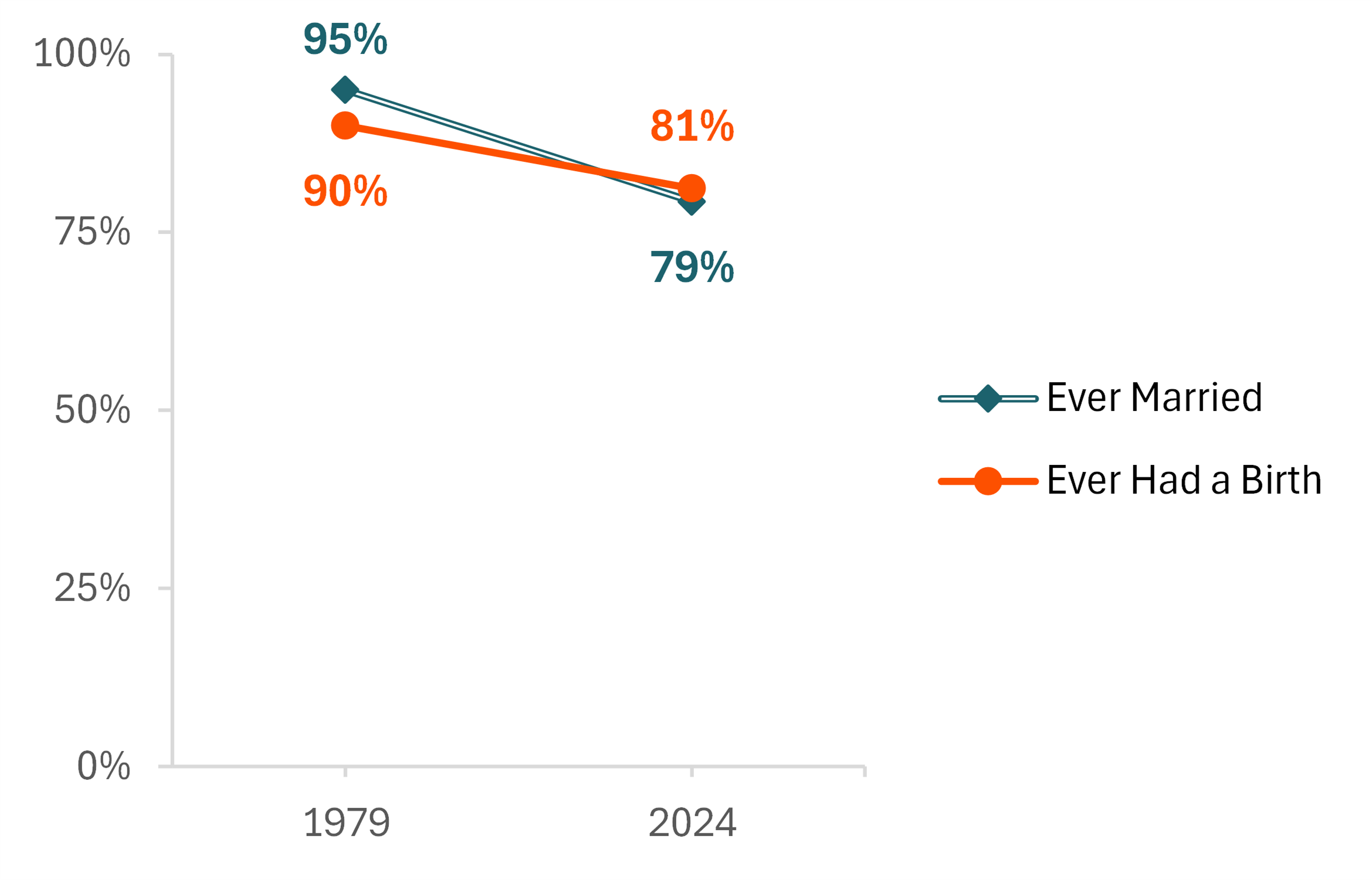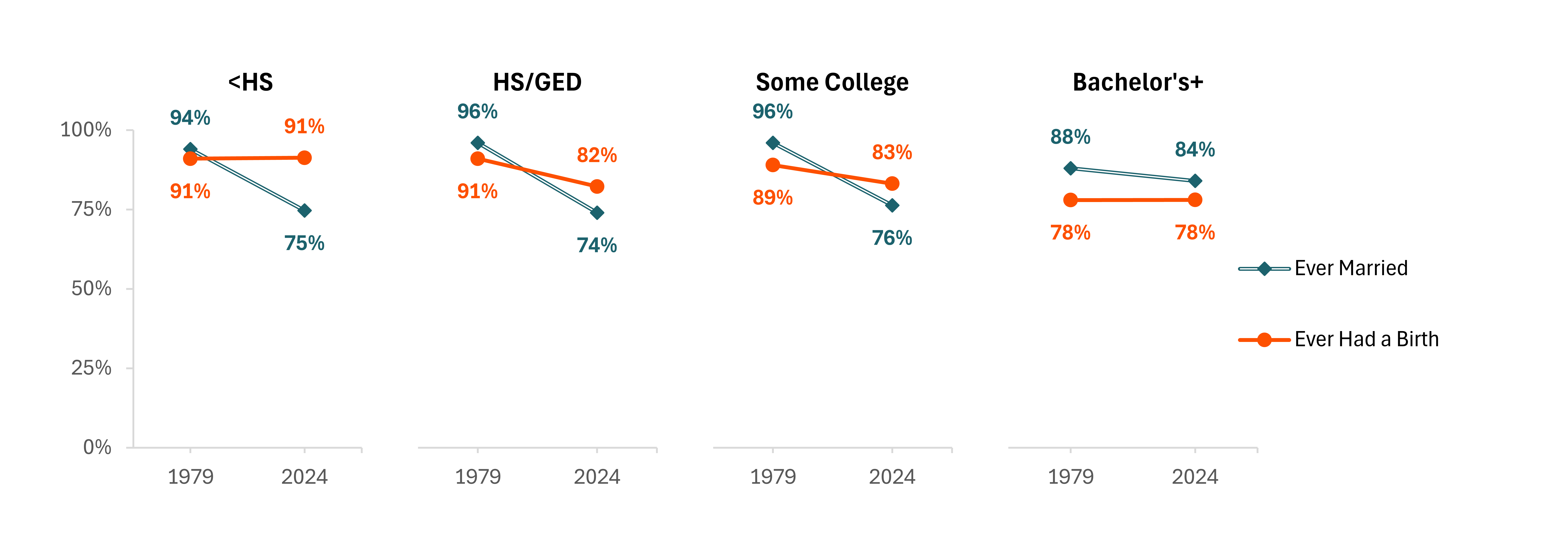Forty-Five Years of Change in Marriage and Motherhood Among Women, 1979 & 2024
Family Profile No. 14, 2025
Author: Krista K. Westrick-Payne
Since 1979 the median age at first marriage has steadily increased (Westrick-Payne, 2024a) while the refined marriage rate has decreased by about half (Westrick-Payne, 2024b). At the same time, the general fertility rate has also declined (USA Facts, 2024) reflecting broad societal shifts in relationship timing and family formation. These trends underscore the importance of examining long-term changes in women’s marital and maternal trajectories between 1979 and 2024. This profile compares data from the 1979 and 2024 Fertility Supplement of the Current Population Survey to examine differences in the shares of women who ever married and ever had a birth by the end of their childbearing years (defined as ages 40-44). This represents the experiences of women born between 1935 and 1939 (part of the Silent Generation) and women born between 1980 and 1984 (those on the cusp of the Millennial Generation). Overall trends are examined as well as trends by race and ethnicity and educational attainment. This is an update of a previous profile FP-22-19 (Brown, 2022).
Changes in the Shares of Women Who Married and Had a Birth
- In 1979, 95% of women aged 40-44 had ever married and 90% had ever had a birth.
- Both the share of women who had married and the share who had had a birth decreased between 1979 and 2024, such that 81% had ever married in 2024 and 79% had ever had a birth.
- The decline in marriage was greater than the decline in motherhood.
Figure 1. Shares of Women Aged 40-44 Who Ever Married and Had a Birth in 1979 & 2024

Changes in the Shares of Women Who Married and Had a Birth by Race and Ethnicity
- The share of White women aged 40 to 44 who had ever married declined from 96% in 1979 to 85% in 2024. The share who had a birth declined from 90% to 79%—the greatest decline among the three racial/ethnic groups examined.
- Black women aged 40 to 44 experienced a large decline in the share who had ever married and a small decline in the share who had a birth. In 1979, both the share who had married and the share who had a birth was 89%. In 2024, only 59% had ever married and 80% had ever had a birth.
- In 1979, similar to White women, a greater share of Hispanic women aged 40 to 44 had married than had a birth (93% and 88%, respectively). By 2024 a smaller share had ever married (74%) than had a birth (87%).
Figure 2. Shares of Women Aged 40-44 Who Ever Married and Had a Birth in 1979 & 2024 by Race/Ethnicity

Changes in the Shares of Women Who Married and Had a Birth by Educational Attainment
- In 1979, the share of women aged 40 to 44 who had ever married was larger than the share who had a birth across all four educational attainment groups examined. By 2024, this remained true only among women with a bachelor’s degree or more.
- The share of ever married declined across all educational attainment groups but declined the most among those with a high school diploma or equivalent (96% to 74%) and least among women with at least a bachelor’s degree (88% to 84%).
- The share of women aged 40 to 44 who had a birth decreased among those in the two middle educational attainment groups (high school/GED and some college). The share remained the same among those with less than a high school diploma (91%) and at least a bachelor’s degree (78%).
Figure 3. Shares of Women Aged 40-44 Who Ever Married and Had a Birth in 1979 & 2024 by Educational Attainment

Data Source:
U.S. Census Bureau (1979 & 2024). Current Population Survey: June Fertility Supplement [Data sets]. Conducted for the Bureau of Labor Statistics. U.S. Census Bureau. https://www.census.gov/data/datasets/time-series/demo/cps/cps-supp_cps-repwgt/cps-fertility.html
References:
Brown, A. R. (2022). Forty years of change in marriage and motherhood among women, 1979 & 2020. Family Profiles, FP-22-19. Bowling Green, OH: National Center for Family & Marriage Research. https://doi.org/10.25035/ncfmr/fp-22-19
Westrick-Payne, K. K. (2024a). A decade of change in the median age of first marriage: 2012 & 2022. Family Profiles, FP-24-07. Bowling Green, OH: National Center for Family & Marriage Research. https://doi.org/10.25035/ncfmr/fp-24-07
Westrick-Payne, K. K. (2024b). Marriage rate in the U.S.: Geographic variation, 2023. Family Profiles, FP-24-25. Bowling Green, OH: National Center for Family & Marriage Research. https://doi.org/10.25035/ncfmr/fp-24-25
Suggested Citation:
Westrick-Payne, K. K. (2025). Forty-five years of change in marriage and motherhood among women, 1979 & 2024. Family Profiles, FP-25-14. Bowling Green, OH: National Center for Family & Marriage Research. https://doi.org/10.25035/ncfmr/fp-25-14
This project is supported with assistance from Bowling Green State University. From 2007 to 2013, support was also provided by the U.S. Department of Health and Human Services, Office of the Assistant Secretary for Planning and Evaluation. The opinions and conclusions expressed herein are solely those of the author(s) and should not be construed as representing the opinions or policy of any agency of the state or federal government.
Updated: 05/09/2025 11:05AM

